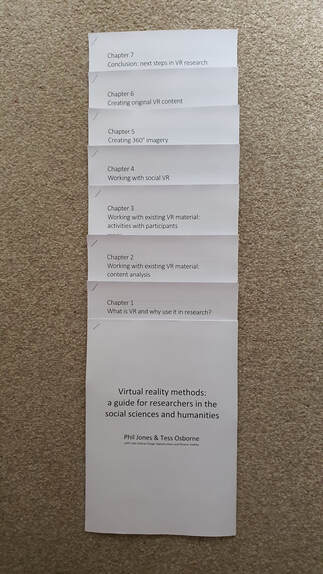 Tess and I have just sent off the manuscript for a new book to Bristol University Press. Assuming the publishers don’t hate it, Virtual reality methods: a guide for researchers in the social sciences and humanities should be coming out sometime in Spring 2022. The reason for talking about this here is not simple self-promotion (although of course there’s always an element of that in this blog) but as a chance to reflect a little bit on getting students involved with research. The book is co-authored between myself and Tess, with three of our former masters students who did projects within my Playful Methods Lab. All three had previously taken my third year undergraduate module which featured material on embodiment and technology and used their masters year to work with me to expand on these ideas. The book is structured around critical reviews of different methods for using VR in research, with each chapter also containing a brief worked example from the lab, three of which came from these masters projects. After a bit of negotiation with the publishers, they agreed that we could give Calla, Tash and Eleanor a ‘with’ author credit, since we were drawing on parts of their work. As a result, the book in some ways represents a bit of a mission statement for an agenda I’ve been promoting at Birmingham to get students emerging from their degree as confident, independent researchers. This isn’t about trying to drag more students into PhD programmes but rather trying to equip them with useful employability skills of being able to identify problems and work on tasks to produce solutions. We’ve restructured our first year programme to build in applied skills from the start of their degrees. I blogged last year about rewriting our GIS teaching. Some of this was about switching from ArcGIS to QGIS so that students could more easily work remotely in the context of the pandemic. More than this, however, the rewritten material was about introducing some basic techniques but focussed on asking them to design their own research projects drawing on these newly learned skills. I’d said to myself at the start of the term that if I could just get them being able to confidently find demographic and make choropleth maps of it without being led through it step-by-step then I would treat that as a huge win. As it turned out, the students produced a wide range of really interesting projects, from census and crime mapping, to looking at air quality and river systems. What gave me most joy, however, was the way that the students were able to apply their GIS skills to other projects. The GIS module is linked to a fieldcourse. Naturally, the students weren’t able to travel this year, so we ran a virtual trip, with staff members ‘taking’ groups to different locations and asking them to apply their research skills to developing research projects about those locations. These projects mostly relied on secondary data sources – though some set up Zoom interviews and online questionnaires. I asked my group of 20 students to investigate topics relating to Melbourne and casually suggested that they might want to make some GIS maps to help their investigations. With no more help from me than giving them the idea, they went off and found Australian census data and shapefiles and produced a whole host of maps that were relevant to their projects. In the old days our students never really did much independent research until their dissertations, which were much more stressful projects as a result because they had relatively little experience of this. By putting research at the heart of the programme now, we’re seeing the confidence in their skills increasing, with a greater willingness to take module content and begin to apply it to explore their own interests. We’re hoping that this makes a real difference to the way that our students are able to sell themselves when applying for jobs. It also means that as we go forward we should have many more projects like those of Calla, Tash and Eleanor that are interesting enough to make their way into the wider scholarly canon.
0 Comments
Leave a Reply. |
AuthorPhil Jones is a cultural geographer based at the University of Birmingham. Archives
September 2023
Categories |
Phil Jones, Geographer
The INTERMITTENTLY updated blog
Proudly powered by Weebly
 RSS Feed
RSS Feed